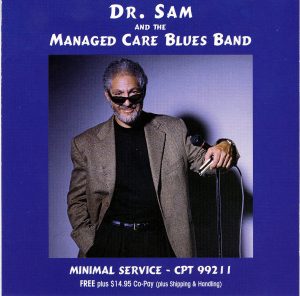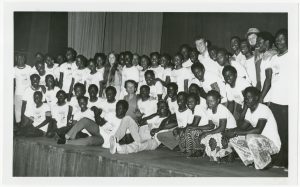
In 1983, the U.S. State Department sponsored a tour by American folk musicians through Zaire, Cameroon, Senegal, and the Ivory Coast. Along with Mike Seeger, the tour group also included Liz Carroll, Mick Moloney, Eileen Golden, Fris Holloway, Sandman Sims, Donny Golden, John Dee Holeman and Alan Belt.
Part of this tour included a Festival of Traditional American Dance held in Abidjan, Ivory Coast between September 26-October 1, 1983, in which the U.S. and Ivorian musicians demonstrated folk music, instruments, and dancing from their respective locales.

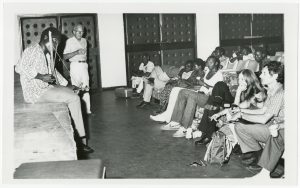
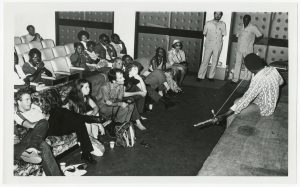

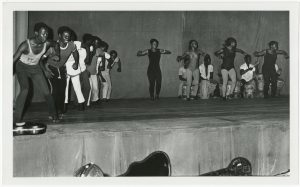
The trip was considered a success, except (as noted in the letter below) that one of the American tour members lost track of their Converse sneakers.
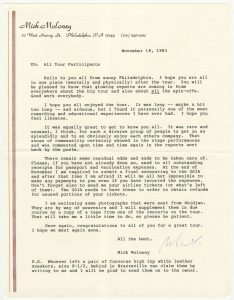 These images were preserved as part of the Southern Folklife Collection‘s digitization project, “From the Piedmont to the Swamplands: Preserving Southern Traditional Music,” funded by a grant from the National Endowment for the Humanities. They are available in the Mike Seeger Collection as Image Folder 20009/0025.
These images were preserved as part of the Southern Folklife Collection‘s digitization project, “From the Piedmont to the Swamplands: Preserving Southern Traditional Music,” funded by a grant from the National Endowment for the Humanities. They are available in the Mike Seeger Collection as Image Folder 20009/0025.
jessiwo
Cataloger's Corner: Stuart Hamblen for President
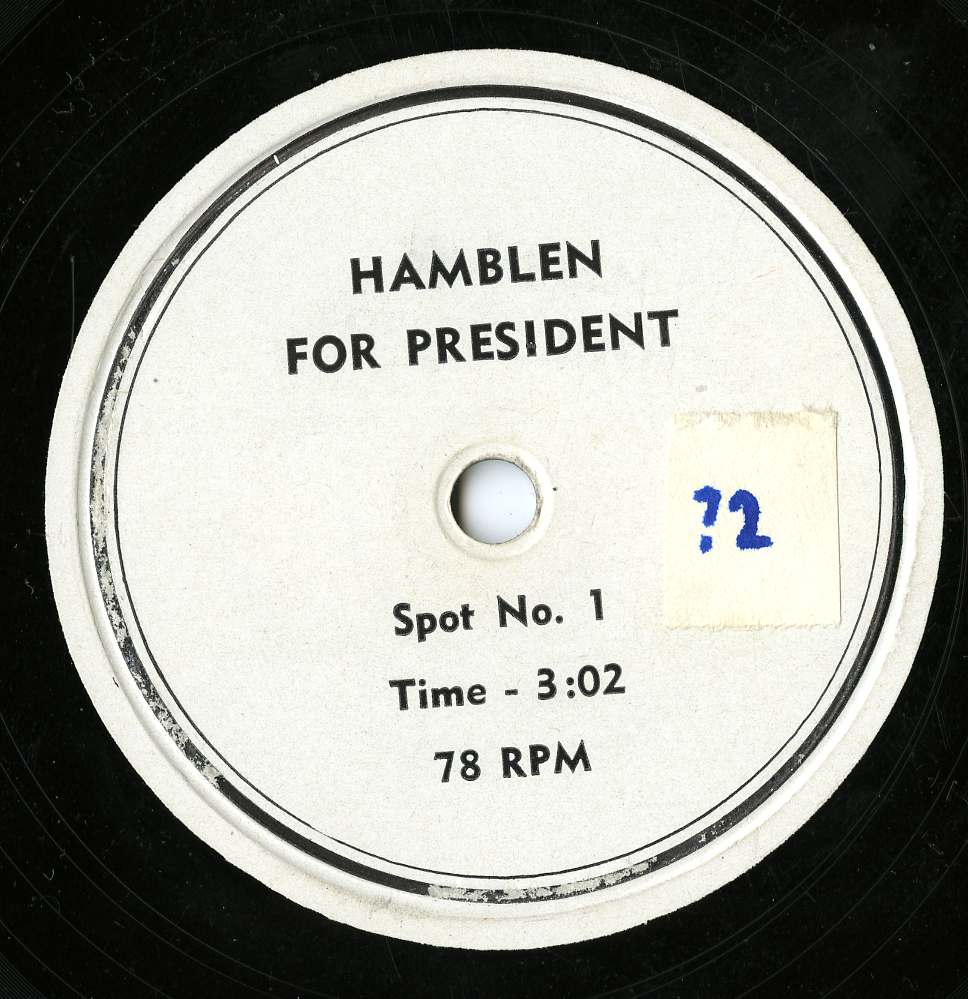
Stuart Hamblen is known today as a singing cowboy who produced radio programs such as “Covered Wagon Jubilee” and eventually “Cowboy Church of the Air.” He was also a major songwriter and recording star—one of the first C&W artists to record for Decca.
A Texas native, Hamblen moved to Los Angeles in the 1920s to start a career in radio. After a brief stint performing with the Beverly Hillbillies, he began hosting his own show. He also began making headlines for his drinking, gambling, and debt-related lawsuits, as well as for owning and training hunting dogs and racehorses. (Incidentally, he was the first person to send a horse to a race on an airplane–Flying Tiger was the name of the airline).
In 1938, Hamblen became one of a series of C&W celebrity-politicians when he ran as a Democrat for congressman of L.A.’s 11th district. (Other examples included W. Lee O’Daniel who served as governor of Texas, Jimmy Davis who served as governor of Louisiana, and Roy Acuff who ran for governor of Tennessee). Hamblen’s candidacy apparently disturbed many Democrats from his district, largely because he campaigned in character, incorporating his guitar and cowboy persona. One Los Angeles Times article referred to him as the “Bourbon candidate for Congress.” Not surprisingly, he did not win.
A decade later, in 1949, Hamblen attended one of evangelist Billy Graham’s tent meetings in Los Angeles—the meeting inspired him to quit drinking and to devote his life to the Christian faith. When his radio station KMTR subsequently asked him to promote a beer brand on air, he refused and lost his show. The beer ad incident put Hamblen on the radar of the Prohibition Party; after General Douglas MacArthur refused the invitation to run as the 1952 Prohibition presidential candidate, Hamblen was recruited for the role. With a retired professor (Enoch A. Holtwick) as a running mate, Hamblen came in 4th place, with 73,412 popular votes.
At the Prohibition Party’s convention, Hamblen played his hit song “It Is No Secret (What God Can Do),” treating it as the theme song of the campaign. At some point during 1951-1952, he used the song as well in a 78rpm recording (likely intended for radio play), entitled “Hamblen for President.” On each side, Hamblen explains his platform and emphasizes that prohibition would not be reinstated if he were elected. A few excerpts from both sides are below.
Hamblen for President, Spot 1
Hamblen for President, Spot 2, beginning
Hamblen for President, Spot 2, middle
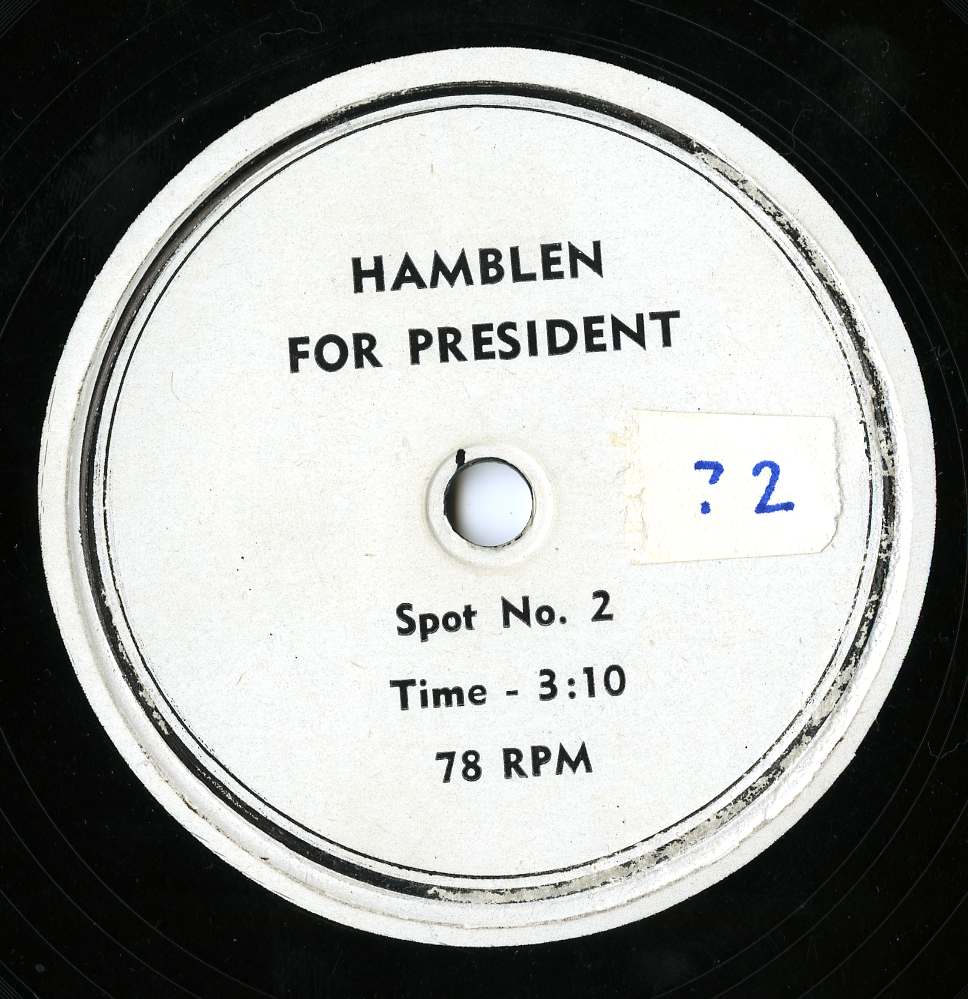
The recording is cataloged and available at the Southern Folklife Collection as 78-17711, along with many of Hamblen’s commercial recordings and reel-to-reel tapes of his radio show “Cowboy Church of the Air.”
Songs from Limestone Country
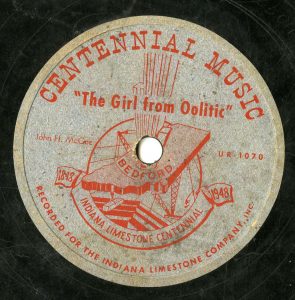
We came across an interesting bit of American industrial history in a recent 78rpm cataloging session in the Southern Folklife Collection: a circa 1948 record promoting the Indiana Limestone Company, featuring on its label a relatively complex illustration of the limestone mining process. Celebrating the 100th anniversary of Indiana’s limestone industry, it includes two songs honoring the state’s favorite sedimentary rock : “Old Limestone Quarry” and “Girl from Oolitic.” (Oolitic is a town in Indiana known for its oolite, a kind of limestone).
We cannot find any information on this release, except that John H. McGee applied for copyright for the two songs in 1949.
We’ve included an excerpt from Side A here, which features an unknown vocalist and big band:
“Old Limestone Quarry”
The record is available at the SFC as call no. 78-17816.
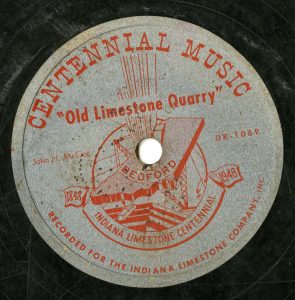
Curley Parker & the Garvin Brothers on Cozy Records
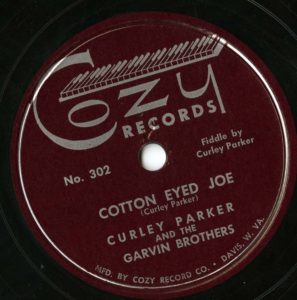 Newly cataloged at the SFC is an obscure bluegrass release on Cozy Records by Curley Parker and the Garvin Brothers, call number 78-17403.
Newly cataloged at the SFC is an obscure bluegrass release on Cozy Records by Curley Parker and the Garvin Brothers, call number 78-17403.
Cozy Records was based in Davis, West Virginia and named after a restaurant in nearby Grafton. It was founded by coal miner and minister John Bava, who’d played and sung along with his wife Lucy in a band called the Country Cousins.
In addition to his record label, Bava also started a magazine called Musical Echoes (printing facilities for which sat in a converted chicken coup), and a music publishing company under his own name. It seems that Bava may have used Musical Echoes partly to promote his compositions among musicians who might perform them. For example, in the SFC’s Sheet Music and Song Lyrics collection, we found this copy of Bava’s composition “Upon the Cross of Calvary” which has a red-and-white sticker referring to Musical Echoes as “song book for the entertainer.”
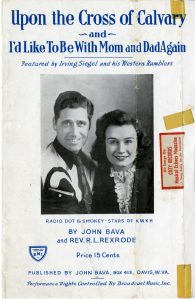
The back cover has been addressed and stamped, with Musical Echoes as the return address. At the bottom, the recipient is told to “request Hank the Cowhand of WMMN, Fairmont, W. Va. to sing ‘Would You Care.’” (Hank recorded this song for Cozy as Hank Stanford & the Sagebrush Round-up some time in the early 1950s; the song was written by Bava).
 Cozy recorded local, West Virginia-based talent, as well as musicians who appeared regularly on radio but who’d had trouble making inroads with bigger labels. Besides Hank the Cowhand, Cozy artists included Cherokee Sue, Rita Flory, Rex Parker’s Merry Men, Chuck Palmer & the Cornmuffins, and eventually the Lonesome Pine Fiddlers.
Cozy recorded local, West Virginia-based talent, as well as musicians who appeared regularly on radio but who’d had trouble making inroads with bigger labels. Besides Hank the Cowhand, Cozy artists included Cherokee Sue, Rita Flory, Rex Parker’s Merry Men, Chuck Palmer & the Cornmuffins, and eventually the Lonesome Pine Fiddlers.
Curley Parker and the Garvin Brothers only made one recording for Cozy Records, “My Guiding Star” / “Cotton Eyed Joe”, released in 1950. Originally from Gilmer County, Georgia, Parker is today best known for having played fiddle with the Blue Sky Boys during the 1940s, as well as for the duo he started with Pee Wee Lambert in 1951. In addition to his musical career, Parker also worked as a land surveyor; ultimately, he phased out professional music appearances in order to focus on his “day job.”
Side A, “My Guiding Star,” features singing by Parker and Earnst Garvin in a song about the unexpected death of the narrator’s fiancé. We’ve included an excerpt here:
My Guiding Star
Side B, “Cotton Eyed Joe,” is an instrumental, and showcases Parker’s fiddling technique (as well as that of an unnamed banjoist, presumably one of the Garvin Brothers). The virtuosity is especially apparent towards the end when the tempo verges on breakneck.
Cotton Eyed Joe
It does not appear that the Garvin Brothers have any surviving output beyond this release.
Our copy of the Parker-Garvin Brothers release came from SFC donor Guthrie Meade and was autographed by Parker. In the image below, you can (sort of) see the inscription on the lefthand side of the label: “To Gus, Curley Parker.”

Cataloger's Corner: Trumpet Records

Newly cataloged at the SFC is a 1953 release by the Carolina Kings of Harmony on Trumpet Records, call no. 78-16736. Trumpet Records was based at 309 N. Farish Street in Jackson, Mississippi, at a combined furniture and record store in one of the city’s African American commercial districts. When Lillian McMurry and her husband (both white) first moved into the space, Lillian found some 78rpm R&B records that the previous tenant had left behind. Upon listening to the records, she fell in love with the sound and decided to sell recordings by black artists out of the store. She also attended blues and gospel performances by touring musicians at the Alamo Theater down the street and got the idea to start her own label featuring those genres.
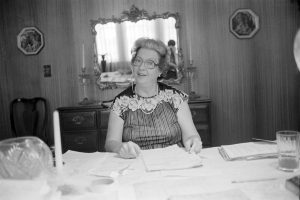
In the summer of 1950, Lillian established her label as the Diamond Record Company—and then learned that Diamond was already in use as a record label name. Since she planned to record music with a spiritual theme, she chose Trumpet Records as a second option—“trumpet” referring to the angel Gabriel’s signature instrument. Lillian searched for talent at the Alamo, in her shop’s listening booths (where customers often sang along to the records), and through word-of-mouth. When she heard about vocalist and harmonica player Sonny Boy Williamson II, she canvassed the area until she found him. Sonny Boy went on to record a number of songs for Trumpet between 1951-1955 before signing to Chess Records. According to Marc Ryan in his book on Trumpet Records, Sonny Boy had such respect for Lillian that he observed her requests to leave all weapons outside the recording studio, as well as to stop all foul language on the Trumpet premises.
The Carolina Kings of Harmony met Lillian and signed a contract with Trumpet after a tour stop in Jackson. Consisting of lead singer Weldon Gill (who also ran a diner in Lewisburg, NC), along with William Battle, T.D. Jones, Vernon Joyner, Bennie Ruffin, Paul Cooley, the group recorded four sides in April 1953 in Raleigh, NC. Dubs of the recordings were then sent on to the Audio Company of America in Texas for mastering. Two of the tracks, “Going On Home to Glory” and “There’s a Narrow Path to Heaven” were released as Trumpet 207; the other 2 were not released until the 1994 Alligator Records compilation, In the Spirit: The Gospel and Jubilee Recordings of Trumpet Records.
We’ve included an excerpt from “There’s a Narrow Path to Heaven” here: There’s a Narrow Pathway to Heaven, Carolina Kings of Harmony
Though Trumpet Records only lasted until 1955 (partly because there was so much competition in the Southern gospel and blues market at the time), it has since become known as the first nationally known Mississippi-based label. Additionally, Lillian McMurry is now recognized as a key figure in the birth of American rock ‘n’ roll and as someone who resisted racial segregation of 1950s Mississippi. In 1998 she was inducted into the Blues Hall of Fame. Her papers, including significant documentation of Trumpet Records, are available for research at University of Mississippi’s Special Collections.
Cataloger's Corner: Bluegrass on Blue Ridge Records
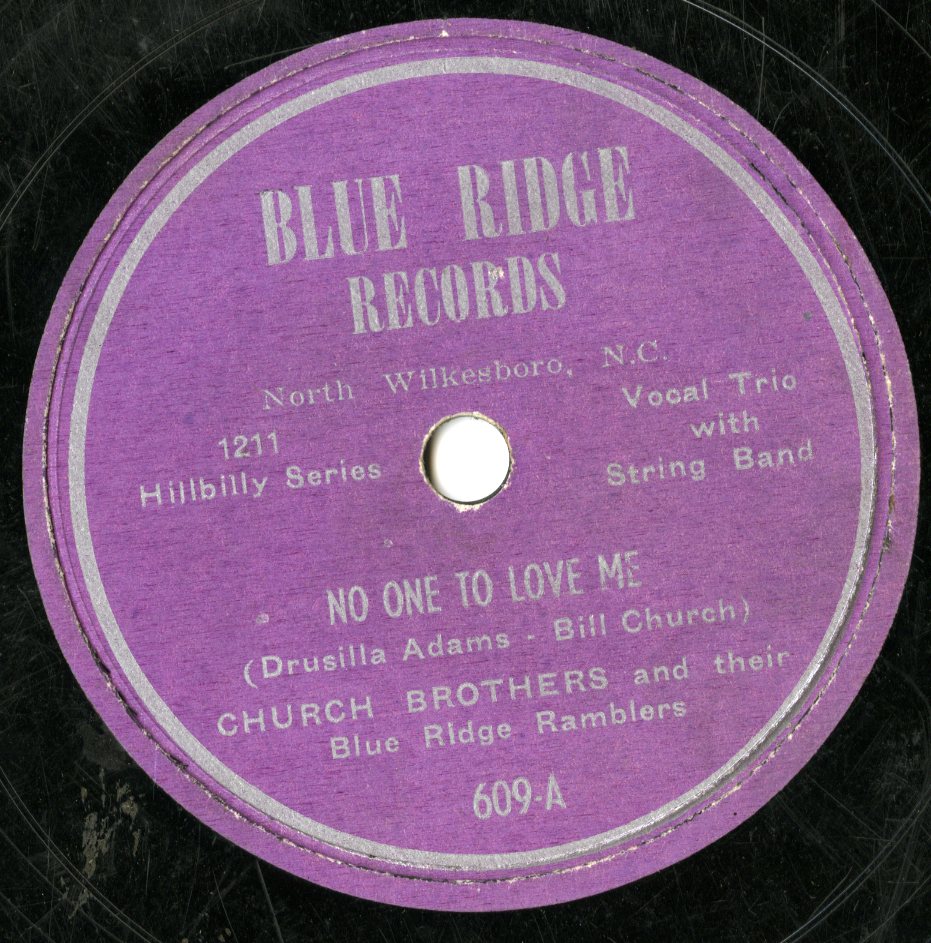
Newly cataloged at the SFC (call no. 78-16864) is a 1952 release by the Church Brothers & their Blue Ridge Ramblers, a short-lived ensemble on a short-lived label, both based out of Wilkes County, North Carolina.
The oldest of the three Church Brothers, Bill Church, had played during the 1940s with Roy Hall & his Blue Ridge Entertainers and on a radio show in Asheville, N.C. called “Farm and Fun Time.” After serving in World War II, he and his brother Ralph began playing with cousin Ward Eller and a few other locals—Drake Walsh (son of Dock Walsh), Gar Bowers and Elmer Bowers. Eventually a third Church brother (Edwin) joined the group. Calling themselves the Wilkes County Entertainers, they played on the local radio stations WILX and WKBC and at schoolhouse shows.

By the 1950s they were performing as the Church Brothers and their Blue Ridge Ramblers and making recordings with a lineup featuring Bill Church (guitar), Edwin Church (fiddle), Ralph Church (mandolin), Ward Eller (guitar), Ralph Pennington (bass), and Johnny Nelson (banjo). They also began recording songs written by a local lyricist, Drusilla Adams. Initially the band planned to have these recordings come out on Rich-R-Tone Records (at the time based in Johnson City, TN). Because of various delays, Drusilla and her father decided expedite the process by setting up their own Wilkesboro-based label called Blue Ridge Records, which issued several Church Brothers singles. Blue Ridge Records went on to record the Stanley Brothers and Bill Clifton; the label lasted until 1958 when Noah Adams passed away and it was sold.
The single “No One to Love Me,” featured here, received a somewhat mixed review from Billboard magazine: “A lively performance by the Church Brothers with hoedown accompaniment of a so-so piece of material.” About the B-side, “You’re Still the Rose of my Heart,” the critic simply stated: “More of the same.”
We’ve provided an excerpt from “No One to Love Me” here: here.
In addition to their releases on Blue Ridge, the Church Brothers & their Blue Ridge Ramblers eventually did go on to sign a contract with Rich-R-Tone, recording several tracks for that label. In 1952, the group disbanded—though the members continued to play on their own at various dance events in the Wilkesboro area.
The Church Brothers’ output on Blue Ridge Records and was later released on LP compilations by Gerd Hadeler Productions and Rounder Records. These LPs are also available at the SFC, as FC-4743 and FC-2046, pictured below.

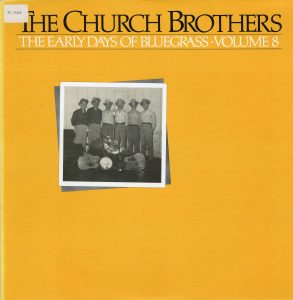
An article and video feature on former Rambler Ward Eller’s experiences with the band appeared in the March 2014 issue of Mountain Music Magazine.
Cataloger's Corner: Barns
Our Photos of the Week this time feature 2 examples of tobacco barns taken from the CD-ROM companion to John Michael Vlach’s 2003 book Barns (Norton/Library of Congress). The book and accompanying disc feature black & white photos of barns across the U.S., taken by a variety of photographers, and currently housed the Prints & Photographs Division of the Library of Congress.


The Barns CD-ROM is now available at the Southern Folklife Collection as call # CD-11794.
Cataloger's Corner: Moondog!
During a recent cataloging session, we stumbled across this 1953 EP by composer/performer/inventor/poet/philosopher Moondog (born Louis Thomas Hardin, b.1916-d.1999), hidden in between recordings by Dizzy Dean & his Country Cousins and the Circuit Rider Quartet.
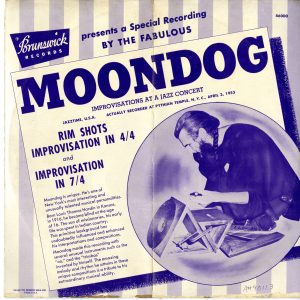
Moondog grew up in the Midwest and became blind at age 16 after playing with a dynamite cap. In the 1940s, he moved to New York City, renamed himself after an ex-pet (a dog who liked to wail at the moon), and stationed himself on a Times Square traffic median where he played his own compositions on instruments that he’d designed and built. Some time during the 1950s, increasing crowds at his performances drove him to relocate to a quieter spot near the corner of 53rd Street and 6th Avenue—and to switch from playing music to standing still for eight hours a day, sometimes reading and selling his poetry. He typically carried a spear, wore a Viking helmet, long beard, and a robe he made from pieces of army blankets. (In 1965, the New York Times reported that he’d changed to a green velvet outfit in order to avoid the “G.I. connotations” of the army blankets).
In the meantime, Moondog also recorded a number of albums for Decca, Prestige, and Columbia and gained recognition as a serious avant-garde composer. Improvisations at a Jazz Concert is the only Moondog record on the Brunswick label. It features two of his self-made, self-designed instruments—the oo (a sort of miniature dulcimer) and the trimba (two small triangular drums with a cymbal attached), as well as his characteristically elastic approach to tempo and meter that he sometimes referred to as “snake time.” Billboard magazine called the EP “one of the unusual recordings of the year” when it came out in 1953, the reviewer suggesting that “those who react to rhythm should be intrigued.”
We’ve included here an excerpt from Side 1, entitled “Improvisation in 7/4.” The EP is available at the SFC, call no. 78-16420.
Improvisation in 7/4 Excerpt

A Moondog documentary is soon to be released, the trailer for which is available here: http://thevikingof6thavenue.com/
Cataloger's Corner: The Dutch Hop Polka

The SFC has just cataloged two rare 10-inch EPs by Paul Weingardt and the Dutch Hop Boys (Vega Records, 1950, SFC call #s 78-16170, 78-16171. The first of these is pictured left.)
The polka on these records is of a special type known as the “Dutch Hop,” played and danced by the Volga Germans in the Great Plains region of the United States. (Eastern Colorado and western Nebraska are particular hotspots for the dance). The “Dutch” in “Dutch Hop” is thought to have started as a disguised version of the word “Deutsch.” During and after the World Wars, German-Americans were harshly stigmatized—and thus willing to portray their origins as Dutch rather than German.
Compared to standard polka, the Dutch Hop is faster, involves “bouncier” steps, and features a hammered dulcimer in addition to more standard instruments like the violin or the accordion. According to the Polka Page website, poor recording quality sometimes made the dulcimer hard to hear on Dutch Hop records. This may explain why the 1950 Billboard review of Weingardt’s Vega release only mentioned the “alternating accordion and violin.”
In this excerpt from “Katy Katy Polka,” the dulcimer is indeed barely audible–one hears it as a faint plucking sound on the offbeats, at phrase endings, and under the violin solo at around 0:45.
Katy Katy Polka
During his career, Weingardt also recorded with the Alpine Dutch Hoppers, the Alpine Polkadots, and the Polka Kings.
Cataloger's Corner: Managed Care Plans–Songs and Music
Newly cataloged and available at the SFC are two releases by Dr. Sam and the Managed Care Blues Band: the full-length album, Minimal Service: CPT 99211, and the single, You Picked a Fine Time to Leave Me Blue Shield (B-side: Mastoid Sally). Liner notes to Minimal Service state that: “These CDs and cassettes are great gift ideas for trade shows, medical conferences, sales reps, party favors, Doctors’ Day, Nurse Day, Nurses Week, Christmas and Chanukah.”
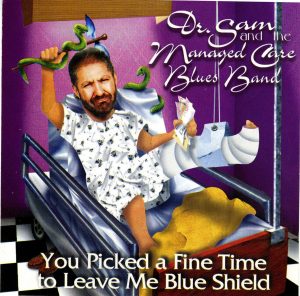
“Dr. Sam” is known in real life as Samuel Bierstock, MD, a practicing physician in Boca Raton, Florida. Since 1996, he has been writing songs on themes of illness, hospital stays, and HMOs, performing and recording them with his blues band in which he sings and plays harmonica. Bierstock and his band have been featured in People Magazine, USA Today and on CNN; they have also mailed their CDs to politicians across the U.S. (including former President Clinton) in order to raise awareness of issues in patient care. The themes tackled by the band are as relevant today as they were in 1990s.

Although, according to the DSATMCBB website, the band’s CDs have been distributed to every member in Congress, the SFC is the only collection listed in Worldcat with copies. In fact, the SFC also appears to be the only repository with holdings in the subject area of “Managed care plans (Medical care) – Songs and music.”
In the track “No Overnight Blues” Dr. Sam sings of a new mother whose insurance company will not pay for an overnight hospital stay.
“No Overnight Blues,” Dr. Sam and the Managed Care Blues Band
